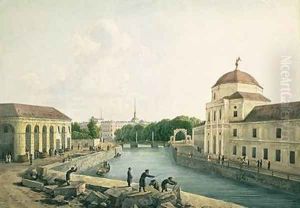Andrei Yefimovich Martynov Paintings
Andrei Yefimovich Martynov was a multifaceted Russian artist whose career spanned the late 18th and early 19th centuries, a period marked by significant cultural and political transformations in Russia. Born in 1768, Martynov was deeply involved in the arts from an early age, navigating the realms of painting, drawing, and watercolor with a particular emphasis on landscape and architectural subjects. His works are notable for their meticulous detail, vibrant color palette, and the ability to capture the majesty of nature and the grandeur of architecture, making him a key figure in the development of Russian landscape painting.
Martynov's education and artistic training were reflective of the broader European influences permeating the Russian art scene at the time. He studied at the Academy of Arts in St. Petersburg, an institution that played a crucial role in the professionalization of Russian art and its alignment with Western European standards. Following his studies, Martynov embarked on a series of travels across Europe, a common practice among artists of his era, which allowed him to study various artistic styles and techniques. These experiences were instrumental in shaping his artistic vision and approach, particularly his exposure to the Italian landscape tradition, which would deeply influence his subsequent work.
Upon returning to Russia, Martynov became involved in several significant projects, including serving as a court painter. His works during this period included not only landscapes but also topographical sketches and views, which were highly valued for their accuracy and attention to detail. These compositions often featured iconic Russian landscapes and historical sites, contributing to the nascent sense of national identity through the visual arts.
Martynov’s later years were marked by a continued engagement with the Russian landscape, though his style evolved to reflect the changing tastes and artistic sensibilities of the time. He remained active until his death in 1826, leaving behind a legacy that would influence the next generation of Russian landscape painters. His works are preserved in several major Russian museums, where they continue to be celebrated for their contribution to the national artistic heritage.
Overall, Andrei Yefimovich Martynov's career encapsulates a pivotal moment in Russian art, bridging the gap between the imported European styles of the 18th century and the emergence of a distinct Russian artistic identity in the 19th century. His dedication to capturing the beauty of the Russian landscape and architecture helped lay the groundwork for the rich tradition of Russian landscape painting that followed.
